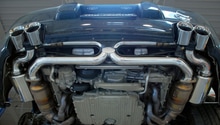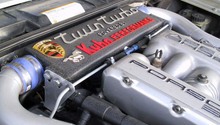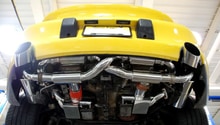Porsche 928: Exhaust Modifications
Increased horsepower, improved torque, and a richer sound are all benefits that various exhaust modifications can provide to a 928 owner.
This article applies to the Porsche 928 (1978-1995).
The Porsche 928 exhaust system is quite robust and was built to last the life of the vehicle. However, owners are typically left wanting when it comes to the performance and sound of the original exhaust as it is quite heavy and restrictive to meet both noise and emission standards. Whether you are a performance buff who is looking to squeeze every last bit of power out of your 928, or an enthusiast who is simply looking to enhance your exhaust note, there are a variety of exhaust system components available to fit the needs of every individual.
Exhaust Modifications
The exhaust system on the 928 is quite lengthy and is comprised of several different components. Starting from the front of the car, the headers are attached to the engine and merge into collectors. The header collectors then attach to a mid-pipe, also known as a Y-Pipe (1978-1986 models) or X-Pipe (1987+ models). The Y or X-Pipe will typically have the catalytic converters installed somewhere after they merge together, but before they reach the mufflers. The end of the Y or X-Pipe finally runs into a series of large mufflers to dampen sound on all 928 models. Although there are quite a few components that complete the exhaust system on a 928, most of them can be mixed and matched to provide owners with specific performance and sound characteristics.
Headers

DIY Cost – $300-1,000
Professional Cost – $1,500
Skill Level – Moderate; Headers are a tight fit and may require the removal of other components for installation.
The first part of a complete exhaust system starts with a set of headers. An exhaust header uses a tubular design that gives each individual cylinder its own piping to extract exhaust gases. These tubes allow the exhaust gases to be scavenged from the cylinders much more efficiently than the stock exhaust manifolds, thus reducing back pressure and improving performance. This is especially true on early 16-valve engine 928 models that have cast exhaust manifolds that severely restrict exhaust flow. Although headers will improve performance across the rev range, various headers utilize different-size primary tubing that can further enhance low-end torque or top-end horsepower. Generally speaking, a set of headers will net performance gains of 8-10% on various 928 models. Unfortunately, most of the companies that manufactured headers for the 928 are no longer in business, so if you are looking for a specific header type, choices are limited mostly to the used marketplace. With that being said, MSDS and 928 Motorsports both currently offer quality headers for the 928.
Mid-Pipe (X or Y-Pipe for Headers)
DIY Cost – $500
Professional Cost – $150-300
Skill Level – Professional; A mid-pipe must typically be fabricated to fit headers unless buying a header/mid-pipe combo.
For owners who opt to install headers, the factory mid-pipe will no longer fit the collector flange of the headers, and a new header-specific mid-pipe must be installed. Most headers will require a muffler shop or similar to fabricate a new X or Y-Pipe to tie the headers into the remainder of the exhaust system. However, 928 Motorsports offers an X-Pipe to fit their headers for owners who do not want to fiddle with having a custom mid-pipe made. While it may seem like a bit of trouble to go through, a set of headers fitted to a new mid-pipe will yield the highest performance gains. This type of setup can yield upwards of 35 peak horsepower and 40 pound-feet of torque. This is possible because the exhaust pulses of both cylinder banks are now able to travel a smoother, less restrictive path and do not intersect with each other as is the case with the stock mid-pipe.
Mid-Pipe (X or Y-Pipe for Stock Manifolds)


DIY Cost – $500-600
Professional Cost – $150-300
Skill Level – Easy to Hard; While it may be cheaper to have a professional mid-pipe fabricated, it can be less of a hassle to install a tried and true mid-pipe that you can install by yourself.
For owners who opt to stick with the factory exhaust manifolds, but are looking for additional performance gains over a cat-back system, an aftermarket X or Y-pipe will fit the bill. Considered by most 928 owners to be the "best bang for your buck" when upgrading exhaust system components, an X or Y-pipe alone can yield increases of 20-30 horsepower and also improve the exhaust note. Early 928's (1978-1986) with 16-valve engines utilize a single exhaust system design in which both exhaust banks merge together to form a "Y." Later models with 32-valve engines (1985-1995) have a dual exhaust system that allows both exhaust banks to merge together to form an "X" shape. These two mid-pipe designs are not interchangeable between cars unless converting the whole exhaust system. Owners who have done a mid-pipe exhaust mod alone report a much freer revving engine that elicits a slightly louder and throatier exhaust compared to stock. Both mid-pipe designs are easy to install, and it is worth noting that the transmission and clutch are much more accessible than they are with the stock mid-pipe installed. The best part is that several companies are now making mid-pipes that tie directly into the stock exhaust system and eliminate the need to have one custom made.
High-Flow Catalytic Converters

DIY Cost – $400-600
Professional Cost – $500+
Skill Level – Easy to Moderate; Modification to mid-pipe may be required to install catalytic converters.
The stock catalytic converters on the 928 are very restrictive. Fortunately, modern catalytic converters, also known as "High-Flow Cats," are able to significantly increase flow while still cleaning up exhaust emissions. These high-flow cats are installed in the mid-pipe and are available in varieties ranging from 100 to 300 cells per inch. Surprisingly, these new cats only give up 5-10 horsepower on a totally cat-less system. Check your state and local laws to determine the best option for your given exhaust application.
Rear Muffler Bypass

DIY Cost – $100-300
Professional Cost –$100+
Skill Level – Easy; This is the simplest exhaust mod that you can do to your 928 without any further modification to the factory exhaust system.
If you are simply looking for a richer exhaust note out of your 928, look no further than a Rear Muffler Bypass. The factory rear muffler on the 928 is extremely restrictive, is quite heavy, and allows very little exhaust note to be heard. The Rear Muffler Bypass has been given extremely positive reviews among members of the 928 community because of its simplicity to install (requires no modifications) and the powerful V8 exhaust note it gives the 928. Not to mention it is a bit less restrictive than the factory rear muffler and has been proven to offer a few extra horsepower. Several companies offer a bolt-on Rear Muffler Bypass, but a quality muffler shop can easily fabricate an new muffler for a bit less. As much as the Rear Muffler Bypass livens up the exhaust note, it is not recommended if you plan on doing any other exhaust modifications as it becomes a bit too loud for the average 928 owner.
Cat-Back System

DIY Cost –$650-2,000
Professional Cost – $800+
Skill Level – Easy; Requires no modification to the stock exhaust manifolds or catalytic converters.
A cat-back exhaust is an all-in-one system that replaces all of the exhaust components that are located behind the catalytic converters. These types of exhaust systems do not affect emission equipment and typically include all hardware needed to install it in place of the factory system. They provide fair horsepower and torque increases all while improving the exhaust note. The best part of a cat-back exhaust system is that they are easy to install, and the guesswork of mixing and matching exhaust components is eliminated. While they may not improve performance as much as a full exhaust system, the components of a cat-back exhaust can typically still be used if, at a later time, you want to install headers or a mid-pipe. Cat-back systems are available for both 16-valve and 32-valve engine 928 models.
Related Discussions
- X-Pipe for Headers? - Rennlist.com
- X-Pipe Benefits - Rennlist.com
- Rear Muffler Bypass - Rennlist.com
- Porsche 928 Header Gains - Rennlist.com






